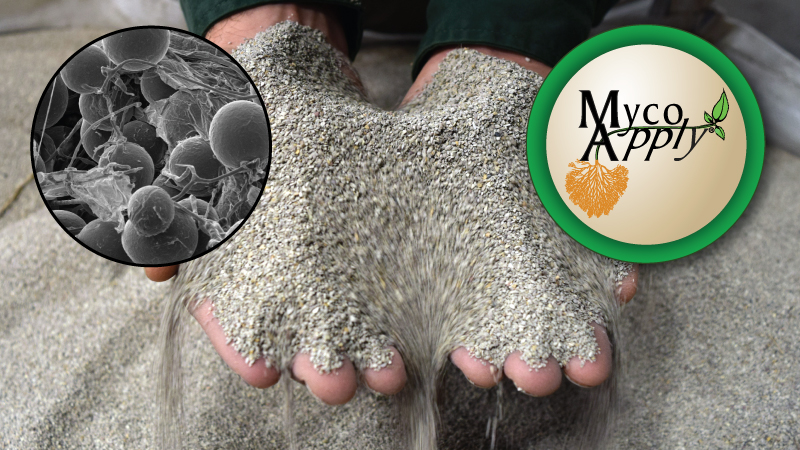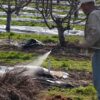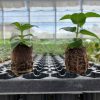By Blair Busenbark, Sales and Commercial Marketing Manager
When I visit a greenhouse or nursery and share with professional growers the value mycorrhizae can offer them in their operation, it often comes down to two simple questions:
“Can my nursery or greenhouse simply add MycoApply® into our production protocol?”
-and-
“What is the value proposition for the use of MycoApply® mycorrhizae?”
Since MycoApply® mycorrhizae can be included in the production process in a variety of ways, the first question is often quickly resolved. We offer both granular and powder mycorrhizal inoculants that can be incorporated in a growing media. This can be done by the grower directly, or the incorporation can be done at a commercial soil mix supplier. Often the option that makes sense in many commercial operations is to apply our suspendable powder mycorrhizal inoculant product options as a liquid drench. For some growers the drench can be applied in the planting line, or once the plants are placed in the greenhouse. Smaller growers have adopted the use of a plug dip to apply the liquid mycorrhizal suspension. This method works for growers that bring in most of their plant material in plug or propagation trays. Bare root transplants can also be dipped. The versatility of applications allows the inclusion of mycorrhizae in most production protocols to be seamless.
The issue of grower profitably has been in the forefront recently, since Dr. Charlie Hall completed a research study for AmericanHort. In the 2018 article titled, “An Index of Prices Paid by Growers in the Green Industry”, Dr. Hall summarized “The cost of producing nursery and greenhouse crops is about 1/5th higher in 2017 than it was in 2007.” This would not necessarily be of such importance if it were not for the fact that the green industry has held prices to their customers relatively flat over the same period of time. The combination of these factors has reduced the overall profitability of the ornamental horticulture growing industry. Growers have responded to this by trying to reduce costs, and if possible, raise prices.
Now you are probably wondering how mycorrhizae fit into this economic discussion? Before I connect the dots, I need to quickly review the documented benefits of mycorrhizae for plant growth and performance. Close to ninety five percent of all plants form relationships with mycorrhizae. In nature it is a survival response. Mycorrhizae provide a major benefit when they become associated with a plant: they expand the root mass of the plant. This expanded root mass comes from the development of a hyphal network of microscopic mycelium in the soil, which is attached to the plant’s root system, and becomes a living extension of the roots. The increase in root mass helps the plant in two major ways: First it allows the plant to be more effective in the uptake and utilization of nutrients. And secondly, the larger root mass increases the efficiency in the uptake and utilization of water.
These two major benefits from the use of MycoApply® mycorrhizae reverberate into a collection of benefits for the grower, the retailer, and ultimately the end user, whether they are a landscaper or a home gardener. These benefits vary depending on the grower and their customer base. Some of the more common benefits from mycorrhizal usage in a greenhouse or nursery are:
- Improved water uptake by the plant leads to reduced water stress and wilt during production and at retail. This results in less plant loss, higher plant grade out, and improved retail shelf life.
- Increased efficiency in the uptake of nutrients results in a higher utilization of the fertilizer you apply, reduced N and P runoff, temporary fertilizer reserves (part of the mycorrhizae structure) during time of shortage, and the ability to transform nutrients into a usable form for the plant. This results in the potential to grow with less fertilizer, less environmental issues, and improved retail shelf life.
- Reduced crop time is often reported by growers that use mycorrhizae, as the increased root mass allows the plant to focus on its primary objective of flowers, yield, and/or maturity. This results in lower production costs and improved profitability.
- More saleable plants is a key benefit from mycorrhizae use, with less loss during production, improved crop uniformity, and reduced transplant shock as you bump plants up to larger containers. This results in higher plant grade out and improved profitability.
- Enhanced shelf life at retail, as plants come off the truck looking better, with nutrient and water reserves stored in the mycorrhizae improving plant appearance, and reducing transplant shock experienced by the end user. This results in better retail performance, fewer product returns, and increased customer/end-user satisfaction.
- Bolstered overall plant health. Mycorrhizae are not an EPA registered product (and therefore make no claims regarding disease or pest resistance), but we all know that if a plant has better roots, it is a healthier plant, when the plant is less stressed, it becomes less susceptible to plant diseases and insect issues. University research also supports mycorrhizae positively improving a plants ability to repel root diseases.
After reviewing the major benefits from the use of mycorrhizae, it can be complex from a grower’s perspective to put an exact dollar value on those benefits. But the evidence is clear that the benefits can be significant, and those same benefits can have a significant positive impact on a nursery or greenhouse operation’s financial bottom line.
So you are probably asking yourself: “How much does it costs to use mycorrhizae?” Before I answer that question, I need to review two factors that impact the financial model for mycorrhizal use. First, once a plant is treated and colonized by the mycorrhizal fungi, the mycorrhizae will remain with the plant’s root system for the rest of the plant’s life. Until recently, most of the mycorrhizae used in greenhouses and nurseries was incorporated in a finishing mix. However, the most cost-effective and grower-beneficial practice is actually to introduce the mycorrhizae at the time of propagation. Since dosage is based on soil volume, applying mycorrhizae in the plug or propagation tray makes the most financial sense since that is when the soil volume is the smallest. Second, it typically takes eight weeks for the benefits of mycorrhizae to more easily be recognized by the grower. If you start the clock at the time of seeding or propagation, then the relationship can start in a smaller soil volume, and once established, the mycorrhizae stays with the plant as it is moved to a larger soil volume container. And it is here in the larger soil volume that the benefits of mycorrhizal usage become more and more apparent.
With all of the above information presented, I can now get to the cost of application. The cost of application for a plug or propagation tray varies based on which tray is used and application method is chosen. The cost for the grower ranges from $0.03 to $0.10 cents per tray to treat with MycoApply mycorrhizae. When you start to divide the cost per tray by the number of plants per tray, the cost per plant is often less than 1/10th of one cent to treat a single plant. That cost is a pretty small price to pay considering the potential plant performance benefits and input reductions outlined in this article.
In summary, for a grower to maximized the benefits and minimize the costs, it is best to treat plants with mycorrhizae during their plug or propagation stage. Inclusion of mycorrhizae in a production protocol is an important tool for growers to use to reduce their costs and strengthen their bottom line. With all of this information, it is easy to conclude that yes, it is cost-effective to utilize this technology, and the returns far outweigh the costs.
Blair Busenbark
Mycorrhizal Applications – Sales & Commercial Marketing Manager
March 13, 2018
© 2018, Mycorrhizal Applications LLC







